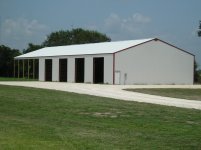RedNeckRacin
Elite Member
- Joined
- Jan 6, 2008
- Messages
- 2,506
- Location
- Western PA
- Tractor
- John Deere 5083E MFWD, Kubota L3400 HST
Oh, I definitely know that position! I was freaking out to get my little cheap-o storage shelter in because it was already past fall cutting and I am poor and cannot buy $10+/bale hay. I barely made it!
Whew, that does suck about the canvas, but I know PA winters can be harsh (grew up in OH river valley, N KY and ohhhh, so much ice and freeze and snow and thaw and ice!). Disclaimer: I do redneck repairs due to aforementioned poverty, LOL, there may be better ways. What I use, although have not tried it on tarp yet, have used a LOT on horse blankets, it retains their waterproofness and breathability, my boys get rough:
Depending on size of hole/tear and my estimate of future stress on area -- I usually hand stitch the edges together (w/ skill roughly equivalent to Dr. Frankenstein), then paint it excessively with this to re-waterproof (Seamsure Seam Sealer 2oz in Blanket Accessories at Schneider Saddlery). If I am in a hurry, want another layer, or have not so much faith in my sewing, I add this (Stormshieldョ Horse Blanket Repair Tape in Blanket Accessories at Schneider Saddlery) which you can slap on just like tape. You CAN iron/heat it for extra stickiness, sew the edges, or, if you are lazy like me, slop more of the magic glue/paint around the edges.
I will be adding this to my fabric shed before spring, it is designed for the shed, but the way it is made, you could put it on any stretched fabric you wanted. You can also replace the plastic rivets with nylon nuts/washers.
ShelterLogic Instant Garage Vent Kit | Anchors, Bungees Accessories| Northern Tool + Equipment
And now you're just rubbing it in. You suck.
Well, the winters play havoc with anything stored outside, and seeing how the tarps are the only line of defense against the elements, they get used and abused. I think my canvas is shot, but i was looking for something to apply to the new one. The holes are partly caused by animals eating it (mice or rats) and the exposure it has gotten from the elements. I am currently using it as is because the darn thing was around $100 i think. I'm not much for sewing but I think I need to look into frankensteining parts of it maybe? I think the water has penetrated into the fabric and I seem to remember an old tarp we had on a dozer that was soaked with diesel and oil that last a good number of years although, for hay that doesn't seem like a very good option! I think I have some leather conditioner but I don't have any idea if that would work on canvas.
I like the vent idea, but I don't think I can bring myself to cut a hole in a $900 tarp. I was actually thinking of a fan with some ductwork to pull the moist air out during the summer time? We have a small unit that we use at work for working on confined spaces that looks like it would work. I know I could get it cheaper since it doesn't need to be intrinsically safe to.
Sorry about rubbing that in. It's not that I'm gloating, but if you have any hesitation about it (price wise is understandable though) you should def. look into mechanizing it.

